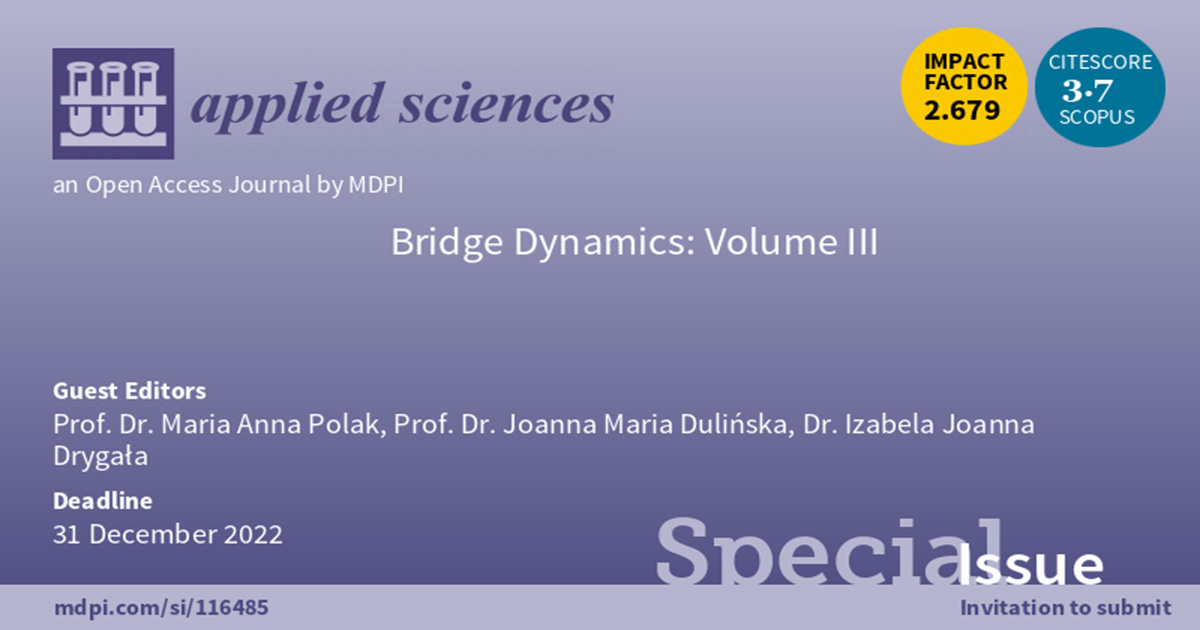Bridge Dynamics: Volume III
A special issue of Applied Sciences (ISSN 2076-3417). This special issue belongs to the section "Civil Engineering".
Deadline for manuscript submissions: closed (31 December 2022) | Viewed by 14900

Special Issue Editors
Interests: structures; mechanics and construction; nonlinear finite element analysis; shear in slabs; strengthening and rehabilitation; nondestructive testing techniques for structural evaluations; Steel and concrete structures; mechanics of reinforced concrete structure
Special Issues, Collections and Topics in MDPI journals
Interests: structures; mechanics and construction; dynamic of structures; bridge dynamics; nonlinear finite element analysis; seismic assessment; spatial variability of earthquake ground motions
Special Issues, Collections and Topics in MDPI journals
Interests: structural dynamics; bridge engineering; seismic engineering; finite element analysis (FEA); structural health monitoring (SHM); vibration analysis; signal processing; bridge design optimization
Special Issues, Collections and Topics in MDPI journals
Special Issue Information
Dear Colleagues,
This Special Issue is a continuation of the previous Special Issues titled Bridge Dynamics (vols. I and II), and is dedicated to academic researchers and civil engineering specialists who want to present their work on theoretical and experimental methods of analysis for dynamic aspects of bridge structures. In view of the significance of dynamic issues for the protection, operation, and feasibility of bridge structures, this Special Issue on Bridge Dynamics aims to bring together authors who want to present their experiences in the research, design, construction, and utilization of bridges, with a focus on dynamics.
Some, though not all, of the problems considered for this Special Issue are as follows: experimental and theoretical investigations of the dynamic characteristics of bridges and footbridges; the seismic performance of bridges and footbridges; the dynamic analysis of railway bridges subjected to high-speed trains; human-induced vibrations of footbridges; the aerodynamic stability of bridge structures; structural health monitoring (SHM) systems; and the integration and management of SHM data for bridges and footbridges.
Prof. Dr. Maria Anna Polak
Prof. Dr. Joanna Maria Dulińska
Dr. Izabela Joanna Drygała
Guest Editors
Manuscript Submission Information
Manuscripts should be submitted online at www.mdpi.com by registering and logging in to this website. Once you are registered, click here to go to the submission form. Manuscripts can be submitted until the deadline. All submissions that pass pre-check are peer-reviewed. Accepted papers will be published continuously in the journal (as soon as accepted) and will be listed together on the special issue website. Research articles, review articles as well as short communications are invited. For planned papers, a title and short abstract (about 100 words) can be sent to the Editorial Office for announcement on this website.
Submitted manuscripts should not have been published previously, nor be under consideration for publication elsewhere (except conference proceedings papers). All manuscripts are thoroughly refereed through a single-blind peer-review process. A guide for authors and other relevant information for submission of manuscripts is available on the Instructions for Authors page. Applied Sciences is an international peer-reviewed open access semimonthly journal published by MDPI.
Please visit the Instructions for Authors page before submitting a manuscript. The Article Processing Charge (APC) for publication in this open access journal is 2400 CHF (Swiss Francs). Submitted papers should be well formatted and use good English. Authors may use MDPI's English editing service prior to publication or during author revisions.
Keywords
- structural health monitoring (SHM)
- seismic assessment of bridges
- aerodynamic assessment of bridges
- dynamic characteristics of bridges and footbridges
- human-induced vibrations of footbridges
- bridge dynamics
Benefits of Publishing in a Special Issue
- Ease of navigation: Grouping papers by topic helps scholars navigate broad scope journals more efficiently.
- Greater discoverability: Special Issues support the reach and impact of scientific research. Articles in Special Issues are more discoverable and cited more frequently.
- Expansion of research network: Special Issues facilitate connections among authors, fostering scientific collaborations.
- External promotion: Articles in Special Issues are often promoted through the journal's social media, increasing their visibility.
- Reprint: MDPI Books provides the opportunity to republish successful Special Issues in book format, both online and in print.
Further information on MDPI's Special Issue policies can be found here.







